Ecology
Background Information:
Ecology
is the study of the relationship between organisms and their environment.
The term was first used by Ernest Hackel in 1866. Ecology includes
the study of:
- populations of the same species of organism living in the same
area at the same time,
- communities of a number of species living together,
- ecosystems composed of organisms plus various abiotic factors,
and
- the
biosphere,
all living organisms on Earth and their habitats.
A. G. Tansley was the first to recognize that plants
and animals are components of a system that also includes the physical
factors that affect the system as well as the various cycles, energy
exchanges, etc. that take place in the system. Thus he was the first to use
the term “ecosystem.” Ecosystems are often named for the most
numerous species (for example, beech-maple) but also the areas so named also
include other plants and animals. An Indicator Species is not
necessarily the most numerous, but it does indicate existing conditions.
For example, blueberry and/or broom-sedge are indicative of acid soil,
hydrangea of land slides, and thistle of overgrazing.
Environmental conditions can put selective pressure on
organisms = natural selection, such that only the best fit organisms
survive. These factors include water/humidity, temperature, food/nutrients,
light, etc. If there is too much or not enough of a particular factor, the
organism(s) cannot survive in that area.
Water Cycle:
Many of these factors occur in a cyclical pattern. For
example, in the water cycle, rain lands on the ground, some of it goes into
a river or lake, and from there it evaporates again, creating more water
vapor in the air. Alternately, some of the water may end up in an
underground aquifer and be pumped up through a well. Eventually, some of
the water may be absorbed by a plant or ingested by an animal, then released
when the organism dies.
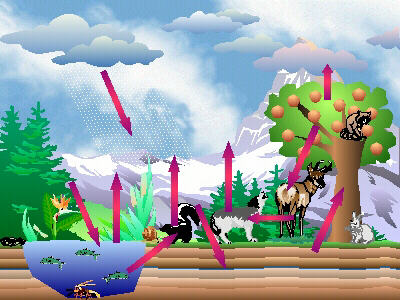
rain → ocean,
lake, river, and ground H2O → plants → herbivores →
carnivores → evaporation from all of the above → rain
The amount of rainfall varies with the overall local climate, season, etc.,
and this, in turn, causes variations in the amount of water in the soil,
therefore available to the local plants and animals. The organisms, then,
must be able to adjust to these variations in available water.
Light Cycle:
There are also temperature cycles, both daily and seasonal.
In response to daily light-dark cycles, many organisms exhibit activity
cycles of about 24 hours, thus are said to exhibit
circadian rhythm.
There are three kinds of circadian rhythm:
| Diurnal
organisms are active during the daytime. |
Crepuscular
organisms are active at dawn and/or dusk. |
Nocturnal
organisms are active during the nighttime. |
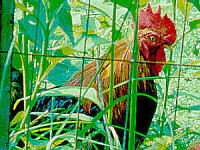 |
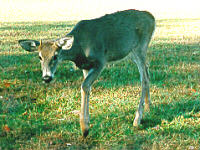 |
 |
Annual changes in day length due to the Earth’s revolution
around the Sun, trigger a number of events in the lives of organisms,
including things like bird migration, hibernation, and time of flowering in
many plants.
Gas and Nutrient Cycles:
Various nutrients, minerals, and gases like CO2,
N2, Fe++ and even pesticides, also go through
cycles. Inorganic material are often converted to organic compounds by
bacteria or plants, thus such organisms are called producers. These
organisms are eaten by primary consumers, or
herbivores.
The herbivores, in turn, are eaten by secondary (or tertiary, etc.)
consumers, or
carnivores.
If any of these organisms dies, there is another group of organisms, the
decomposers, which feed on dead or decaying organic matter. A sub-group
of the decomposers are the
saprophytes,
mushrooms, etc, that are decomposers and were formerly considered to be
“plants.” Eventually, the nutrients are released into the air or soil once
again. The major elements needed by living organisms can be remembered by:
C HOPKINS CaFe, Mighty good, which stands for: carbon, hydrogen,
oxygen, phosphorus, potassium, iodine, nitrogen, sulfur, calcium, iron, and
magnesium. Since many of these are obtained from soil, the amount in an
organism’s diet can vary with the soil type.

Types of Habitats and Succession:
Organisms can be found in and make up a number of types of
habitats. Fresh water habitats include streams, lakes, and wetland areas
including marshes (grassy wetlands), swamps (woody wetlands), and bogs.
Marine areas include costal waters, open water, the bottom mud, and
estuary
areas (area around the mouth of a river where fresh and salt water mix in
various concentrations). Terrestrial habitats include several types of
forest, including both temperate and tropical forests as well as jungle,
which is second growth after a rainforest has been cut, grasslands, tundra,
and desert.
| Pond |
Ocean |
Grassland |
Forest |
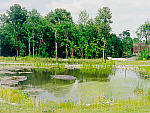 |
 |
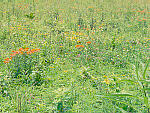 |
 |
Within a given community, the make-up of that community is
not static. New species arrive and are able to grow in conditions provided
by present species, yet these new species further alter the environment,
perhaps such that some species can no longer live there. Thus, other species
eventually die off, and the community make-up changes. This is called
succession. For example, a bare farm field that is left alone will
first be covered by a variety of hardy weeds and grasses. These will
provide enough cover that shrubs such as honeysuckle or, bramble begin to
grow there. Typically, this provides enough shade and humidity that the
first trees, perhaps cottonwood, are able to start growing, and this further
alters the environment such that conifers like eastern redcedar can live
there. Within around 50 to 100 years later, a variety of other trees such
as ashes, cherry, and sassafras are growing there, but there are probably
still a lot of shrubs underneath the trees. Slowly, the composition of the
woods may change such that oaks and hickories are the most numerous species
of trees present. Eventually, these will be replaced by beeches and sugar
maples, which will attain great size and age. Typically, beeches and maples
are “replaced” by more beeches and maples, thus this is said to be the
climax community. Also, the tree canopy os so dense that little
light can reach the forest floor, thus there are few shrubs, and the area is
very open under the trees.
| Bare Soil |
Colonizing |
Old Field |
Forest |
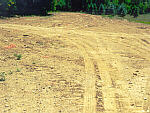 |
 |
 |
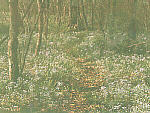 |
Interactions Within and Among Species:
Within a community, the organisms interact with other members
of the same species and with members of other species. An organism’s
niche
is the organism’s role and “address” and job/activities and relationships
(how it fits in) within the community.
Intraspecific interactions
are those in which members of the same species are interacting with each
other and include communication (visual, vocal, chemical/pheromone), care and
protection of young (some species do, some don’t), as well as courtship and
sexual competition. A special case of intraspecific relationships is social
and colonial species of animals, which have dominance hierarchies which are
maintained through interactions among the colony members.
Interspecific interactions
are relationships among organisms (animals) of different species. Some types
of interspecific relationships include:
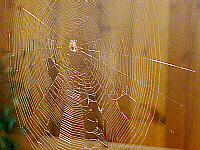
Predation
- Predation,
in which a larger animal eats a smaller one. Lions eat antelope, and wolves
eat deer. Spiders, like this orbweaver, capture and eat insects.

Parasitoid
- Parasitism,
in which a smaller animal feeds on a larger one, often living inside it and
usually weakening or killing it. Often the host is not killed outright.
Because a parasite lives in/on the body of its host and needs the host to
remain alive, it is usually advantageous for the parasite to not kill
its host. Humans and domestic animals are occasionally infected with or
bothered by tapeworms, roundworms, mosquitoes and/or leeches. A
parasitoid
is a parasite that eventually causes the death of its host. By the time the
parasitoid undergoes metamorphosis, all of the host’s innards have been eaten.
Often, insect larvae that are parasitoids of other insects eat the host’s
tissues, timing things such that just as they’re ready to pupate, they have
eaten up the whole insides of their host, and it dies. Braconid wasps do
this to tomato hornworms, and this hornworm, covered with cocoons of
pupating braconids, probably has almost no body parts left inside. If you
see a caterpillar like this on your tomato plants, leave it alone. The
wasps will eventually hatch, mate, and lay eggs in any other tomato
hornworms they can find — a good means of biological control.
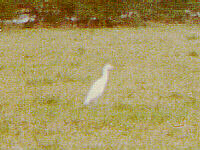
Commensalism
- Commensalism is a relationship that is beneficial to one organism
and of neutral benefit for the other. Cattle egrets follow cattle to feed on
the insects stirred up by the grazing cattle.
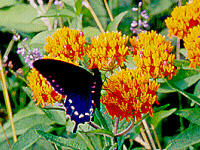
Mutualism
- Mutualism, a relationship between two species where both benefit.
The yucca moth both pollinates and feeds on the yucca plant; acacia ants
live in the thorns of, defend, and are fed by the acacia tree in which they
live; and trees can’t get along without mycorrhizae living in/on their roots
and absorbing food for them. Many plants and their pollinators have evolved
mutualistic relationships. Butterflyweed provides food for and is
pollinated by butterflies like pipevine swallowtails.
All these are types of
symbiosis,
a term describing any kind of relationship between two different species
living and interacting together. This is a general term which includes
predation, parasitism, commensalism, mutualism, etc. Often, however,
symbiosis is used to mean mutualism.

Monarch with
Warning Coloration
To prevent or escape attack by another organism, various organisms have
developed defense mechanisms, such as camouflage, mimicry, warning
coloration, and/or attack to protect themselves from other organisms of the
same or a different species. The bodies of Monarch butterflies contain
chemicals (from the milkweed they ate as caterpillars) that make them taste
bad, and they use warning coloration to advertise this to any
would-be predators.
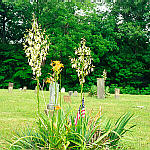
Yucca Plants
On the other hand, coevolution is the evolution of two species totally
dependent on each other. This is an extreme case of mutualism. Examples of
coevolution include things like lichens (in which the fungus and alga cannot
survive without each other), acacia ants (which protect their host acacia
tree and receive food and shelter from it), yucca moths (which are the only
pollinators of yucca plants, while yucca seeds are the only food for their
caterpillars), and a variety of cases of specific pollinators for specific
plants.
Copyright © 1997 by J. Stein Carter. All rights reserved.
Clipart edited from Corel Presentations 8
This page has been accessed  times since 02 Jan 2002.
times since 02 Jan 2002.


















